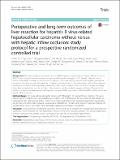Perioperative and long-term outcomes of liver resection for hepatitis B virus-related hepatocellular carcinoma without versus with hepatic inflow occlusion: study protocol for a prospective randomized controlled trial

View/
Author
Xu, Yinzhe
Chen, Jiye
Wang, Hongguang
Feng, Dan
Zhang, Aiqun
Leng, Jianjun
Duan, Weidong
Yang, Zhanyu
Chen, Mingyi
Shi, Xianjie
Cai, Shouwang
Ji, Wenbin
Jiang, Kai
Zhang, Wenzhi
Chen, Yongliang
Gu, Wanqing
Dong, Jiahong
Lu, Shichun
Note: Order does not necessarily reflect citation order of authors.
Published Version
https://doi.org/10.1186/s13063-016-1621-9Metadata
Show full item recordCitation
Xu, Y., J. Chen, H. Wang, H. Zheng, D. Feng, A. Zhang, J. Leng, et al. 2016. “Perioperative and long-term outcomes of liver resection for hepatitis B virus-related hepatocellular carcinoma without versus with hepatic inflow occlusion: study protocol for a prospective randomized controlled trial.” Trials 17 (1): 492. doi:10.1186/s13063-016-1621-9. http://dx.doi.org/10.1186/s13063-016-1621-9.Abstract
Background: The high prevalence of hepatitis B virus (HBV) imposes a huge burden of hepatocellular carcinoma (HCC) in Asia. Surgical resection remains an important therapeutic strategy for HCC. Hepatic inflow occlusion, known as the Pringle maneuver, is the most commonly used method of reducing blood loss during liver parenchymal transection. A major issue with this maneuver is ischemia-reperfusion injury to the remnant liver, and the hemodynamic disturbance it induces in the tumor-bearing liver raises an oncological concern. Given the technical advances in living donor liver transplantation, vascular occlusion in liver resection can be avoided in experienced hands. The aim of this study is to compare the perioperative and long-term outcomes of liver resection for HBV-related HCC without versus with hepatic inflow occlusion. Methods/design This study will include eligible patients with HBV-related HCC elected for liver resection. Fifty-seven patients will be enrolled in each randomization arm to detect a 20 % difference in the serum level of total bilirubin on postoperative day 5 (80 % power and α = 0.05). The secondary endpoints include procedural parameters, perioperative liver function and inflammatory response, postoperative morbidity and mortality, and long-term outcomes. Patients will be followed for up to 5 years. Data will be statistically analyzed on an intention-to-treat basis. Discussion This prospective randomized controlled trial is designed to compare the perioperative and long-term outcomes of liver resection for HBV-related HCC without versus with vascular occlusion. The clinical implications of these outcomes may change current surgical practice and fill the oncological gaps therein. Trial registration Clinicaltrials.gov identifier NCT02563158. Registered on 28 September 2015. Electronic supplementary material The online version of this article (doi:10.1186/s13063-016-1621-9) contains supplementary material, which is available to authorized users.Other Sources
http://www.ncbi.nlm.nih.gov/pmc/articles/PMC5057253/pdf/Terms of Use
This article is made available under the terms and conditions applicable to Other Posted Material, as set forth at http://nrs.harvard.edu/urn-3:HUL.InstRepos:dash.current.terms-of-use#LAACitable link to this page
http://nrs.harvard.edu/urn-3:HUL.InstRepos:29408155
Collections
- HMS Scholarly Articles [17922]
Contact administrator regarding this item (to report mistakes or request changes)


